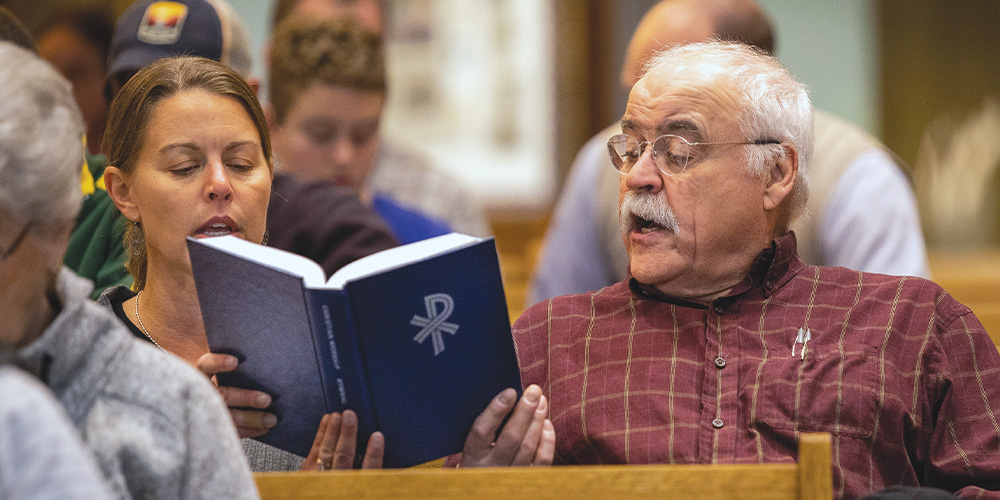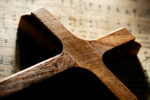 |
Luther’s first congregational hymn puts the gospel right where it belongs: in the mouths of God’s people.
Not everyone rejoiced when Luther’s first congregational hymn “Dear Christians, One and All, Rejoice” (Christian Worship [CW] 557) came rolling off the printing presses in 1523. Many of Luther’s enemies suspected that this hymn and others he wrote were responsible for leading more souls astray than his sermons. Twenty years later in 1543, a French bishop wrote a letter to Pope Paul III to help prepare for a church council that would soon convene in Trent, Italy. Instead of heeding Luther’s call to “rejoice,” the bishop rejected Luther’s hymns:
I say in addition that it will not be very easy for them (namely the Protestants) to agree with us, because it will be necessary after peace is established to do away with those German songs, which they use very much in many of their churches. . . . Who can say how many people have easily been drawn away already from the true religion by these same chants, to which they have already become accustomed for twenty years or more? (Papal Legislation on Sacred Music: 95 A.D. to 1977 A.D., p. 26)
Rome convened her council, but Lutheranism kept her hymns. And so in the year 2023, we can celebrate five hundred years of Lutheran hymnody!
Luther’s early hymnody
Luther’s first hymns came at a time when the Reformation was quickly gaining steam. But then things boiled over. In Brussels, two Augustinian monks were burned at the stake on July 1, 1523, for preaching Lutheran “heresy.” Shaken by their deaths, Luther poured out his heart in a folk-style ballad that retold the story of their martyrdom. The opening line served as a fitting prelude for Lutheran hymnody, “A new song here shall be begun—The Lord God help our singing!” (Luther’s Works [LW], Vol. 53, p. 214).
In December of that same year, Luther began reforming the church’s worship forms with a conservative revision of the Mass. His Order of Mass and Communion did away with the theological errors of the Roman Mass yet retained the Latin language. Near the end of that document, he issued the call for German poets to begin writing hymns in German for the congregation to sing:
I also wish that we had as many songs as possible in the vernacular which the people could sing during mass. . . . But poets are wanting among us, or not yet known, who could compose evangelical and spiritual songs, as Paul calls them [Col. 3:16], worthy to be used in the church of God. . . . I mention this to encourage any German poets to compose evangelical hymns for us” (LW, Vol. 53, pp. 36,37).
Luther answered his own call for German poets by writing 24 hymns within a year from 1523 into 1524. The Lord, indeed, helped his singing!
Luther’s first church hymn
Luther’s second hymn, “Dear Christians, One and All, Rejoice,” was really his first church hymn. In it, Luther tells us his own story and how it was changed by the gospel’s story. After an opening call to sing and rejoice, it provides an ugly snapshot of Luther’s desperation:
Fast bound in Satan’s chains I lay;
death brooded darkly o’er me.
Sin was my torment night and day;
in sin my mother bore me.
Yet deep and deeper still I fell;
life had become a living hell,
so firmly sin possessed me.
My own good works availed me naught,
no merit they attaining;
my will against God’s judgment fought,
no hope for me remaining.
My fears increased till sheer despair
left only death to be my share
and hell to be my sentence. (CW 557:2,3)
In stanzas 4-10, Luther suddenly stops singing about his living hell. Instead, he sings about what Christ did to rescue him—and you and me—from an eternity in hell. From God’s gracious election in eternity, to the cradle at Christmas, to the cross of Calvary, from the empty tomb to Christ’s glorious ascension, the hymn proclaims the gospel in all its fullness. The hymn that began with a sinful heart in shambles ends with the confidence that comes from knowing Christ’s completed work.
The continued significance of Luther’s hymns
Early in 1524, “Dear Christians, One and All, Rejoice” was combined with seven other hymns to make up the first Lutheran hymnal, the so-called Achtliederbuch (German for “Eight-Hymn Book”). These eight hymns had such musical quality, polished poetry, and biblical integrity that four of them are still found today in Christian Worship. In fact, they are sung by millions of Lutherans around the world, and the vast majority do not share a German heritage. Through them, the new song, the song of the gospel, still echoes 499 years later.
Luther’s “new” songs were really nothing new. They simply sang the age-old gospel of Christ. Luther and the other reformers’ hymns proclaimed the cross and pulsed with the power of Christ’s resurrection. The reformers didn’t write their hymns primarily as a means of self- expression. Instead, their hymns were seen as an important means of gospel instruction. Seven years after “Dear Christians, One and All, Rejoice” was written, the Augsburg Confession would embrace this teaching function of Lutheran hymnody: “Almost all the customary ceremonies [of the Mass] are also retained, except that German hymns, added for the instruction of the people, are interspersed here and there among the Latin ones” (Augsburg Confession, Article XXIV:1-3, emphasis added).
Twenty years after the French bishop wrote against Lutheran hymns, a Lutheran theologian by the name of Tilemann Hesshusius wrote about the evangelistic power of “Dear Christians, One and All, Rejoice.”
I do not doubt that through this one hymn of Luther many hundreds of Christians have been brought to the true faith . . . but the noble, precious words of the hymn have won their hearts, so that they are constrained to embrace the truth: so that in my opinion the hymns have helped the spread of the Gospel not a little. (Preface to Johannes Magdeburg’s Psalter of 1565, as found in Christian Worship: Handbook, p. 395)
When Lutherans sing Christ-centered hymns like “Dear Christians, One and All, Rejoice,” they are proclaiming the gospel. Think about that the next time you sing in church! The hymn that you sing is not just between you and God. The hymn you sing is between you, God, and the people in the pews worshiping with you. Luther’s hymn puts the gospel right where it belongs: in the mouths of God’s people.
Take some time to get to know “Dear Christians, One and All, Rejoice” as well as Luther’s other hymns. If you can’t sing, then read and memorize them for your daily devotions. Sing about Jesus’ work like you’re doing so for the very first time. And then, rejoice! Rejoice because someone took the time to sing the gospel to you. And even now, God is using you to bring the gospel to others.
So sing it like you mean it! Because by a miracle of pure grace, you do.
Author: Aaron Christie
Volume 110, Number 08
Issue: August 2023







